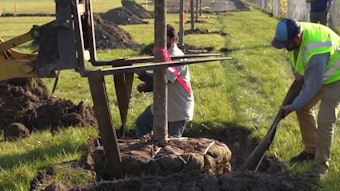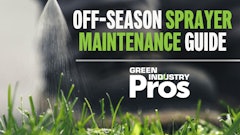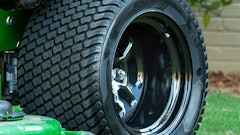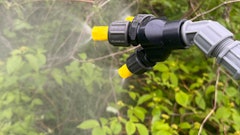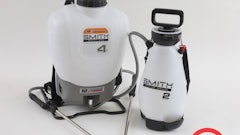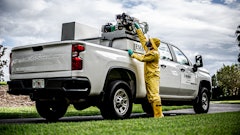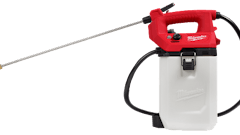
For years, lawn care professionals (LCOs) depended on simple, reliable spreaders and sprayers to help them serve customers. These spreaders and sprayers—including handheld or backpack-sized units up to more complex, self-propelled machines—spread seed and granular products or sprayed liquid products depending on what the customer needed.
As good as these single-purpose machines were, LCOs knew they could be improved. One day somebody decided to make a good thing better and combined a spreader with a sprayer, and the spreader-sprayer as we know it today was born.
Spreader-sprayers are becoming more common and come in a variety of sizes with different capabilities. Because they are so versatile, LCOs owe it to themselves to examine how spreader-sprayers can benefit their businesses. If you aren’t yet using spreaders-sprayers, you can assume that your competition probably is. Even with the obvious advantages, there are a few considerations contractors should take into account before choosing to add these units to their businesses.
Versatility
Contractors can instantly offer multiple services to customers with just one machine: seed and fertilize lawns, spray pesticides and herbicides and apply almost any granular or liquid product on customers’ lawns and landscapes.
Some of the larger spreader-sprayers allow the operator to easily adjust the width of the spray area and the broadcast range of the spreader, as well as the amount and rate of the product used. Some can accept separate auxiliary tanks to increase both the amount and types of products carried onboard.
Spreader-sprayers with large tanks allow operators to mix products for simultaneous application, but operators should always research products to make sure it’s both effective and safe to mix specific products together.
Efficiency
Spreader-sprayers are more efficient because one machine performs two operations—both spreading solids and spraying liquids. Some models can both spread and spray at the same time, giving one-pass ability depending on the products used.
Not only do spreader-sprayers combine two functions into one machine, but they also allow one worker to perform what used to be two separate jobs and help reduce labor costs. Plus, stand-on or ride-on units make one worker able to cover a lot of ground quickly, allowing for more jobs to be done in a single day.
Bigger spreader-sprayers can hold large amounts of both solid and liquid product, reducing the time spent refilling the machine. Some models give the operator very precise control over the exact amount of product used—helping business owners to effectively serve customers without using more product than needed, which helps reduce costs and increase profits.
Initial costs and rewards
Most spreader-sprayers are self-propelled and are either stand-on or ride-on designs. Because they are self-propelled and more complex than just an individual unit, they are often more expensive.
Spreader-sprayers typically fall into one of two drivetrain categories: steerable or zero-turn. Steerable models have wheels that turn and can often fit through 36-inch gates. Zero-turn models operate very similar to zero-turn mowers and can often be larger machines that allow fast operation over large areas.
No matter which drivetrain you prefer, spreader-sprayers are more complex than standalone units, so they typically cost more. Some of the large zero-turn sprayer-spreaders can easily cost tens of thousands of dollars.
Business owners need to factor in what kinds of jobs their business typically handles, the size of their current customer base and the needs of those customers when deciding which model best fits their needs. While a spreader-sprayer can be a large purchase, business owners should consider the potential growth a spreader-sprayer makes possible.
A spreader-sprayer can be a big investment, especially for a smaller business or a new business just starting out. Before buying a new unit, or even a fleet of them, contractors need to do the math to get an idea of how long it might take for it to pay for itself and then start bringing in more profits. For many businesses who are growing and beginning to take on larger commercial and residential properties, adding a spreader-sprayer to your equipment lineup can dramatically improve productivity out on the jobsite.
Test drive and buy
As good as spreader-sprayers are, it’s wise to visit your local dealer and test drive a few models before buying one. Think of spreader-sprayer shopping as like buying a car or truck. Smart vehicle shoppers do their research before arriving at the car lot, but they still test drive cars, sometimes several, before signing the purchase agreement.
Taking the same approach once you’ve decided on a spreader-sprayer can help improve your business and earn more customers.
What’s your price range? Which drivetrain works the best for your area? Do you service a lot of ground with hilly terrain, or do you work on large, flat, wide-open spaces? Who will be driving the spreader-sprayer the most? How much will that operator need to be trained on using the new machine? If your customers often have gates on their property, what size machine will be able to navigate through those gates? These are all questions to consider as you look at different models and test drive them.
Spreader-sprayers are becoming more common in the lawn and landscape business because they allow one operator to perform several different jobs, including both spreading and spraying different products at the same time for true one-pass capability. These units can help a business get more work done per day and increase the number of customers a business can service. While they are relatively complex machines and can be costly, the versatility and efficiency provided pays off in the long run.

